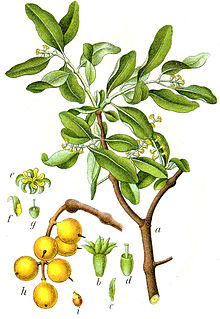
Loranthus is a genus of parasitic plants that grow on the branches of woody trees. It belongs to the family Loranthaceae, the showy mistletoe family. In most earlier systematic treatments it contains all mistletoe species with bisexual flowers, though some species have reversed to unisexual flowers. Other treatments restrict the genus to a few species. The systematic situation of Loranthus is not entirely clear.
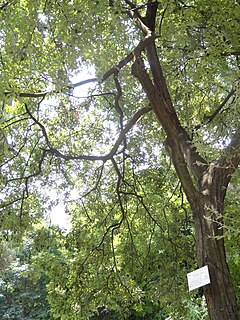
Dichotomanthes is a monotypic genus of flowering plants belonging to the family Rosaceae. The sole species is Dichotomanthes tristaniaecarpa. The flower is perigynous the ovary is superior. The fruit of the plant is a dry achene.

Dendropemon is a genus of mistletoes which is endemic to the Caribbean. Members of the genus are hemi-parasites which normally grow on trees and shrubs, although self-parasitism is known to occur. The approximately 31 species range from The Bahamas and Cuba in the north and west, to Barbados and St. Vincent in the southwest. Diversity and endemism is highest on the island of Hispaniola.

Psittacanthus robustus is a species of neotropical mistletoe in the family Loranthaceae, which is found in Brazil, Colombia, Guyana and Venezuela.

Atkinsonia is a hemi-parasitic shrub with oppositely set, entire leaves and yellowish, later rusty-red colored flowers, that is found in Eastern Australia. It is a monotypic genus, the only species being A. ligustrina, and is assigned to the showy mistletoe family, Loranthaceae. It is sometimes called Louisa's mistletoe.

Amyema gaudichaudii, commonly known as melaleuca mistletoe is a plant in the family Loranthaceae endemic to eastern Australia. Like other mistletoes, it is a shrubby, woody, aerial hemiparasite plant. It has relatively small, wedge-shaped leaves and small, dark red flowers arranged in groups of three. It only grows on a few species of Melaleuca.

Amyema melaleucae, also known as the tea-tree mistletoe, is a species of flowering plant within the genus Amyema, an epiphytic hemiparasitic plant of the family Loranthaceae native to Australia and found in Western Australia and South Australia on the coast, from north of Perth almost to the Victorian border.
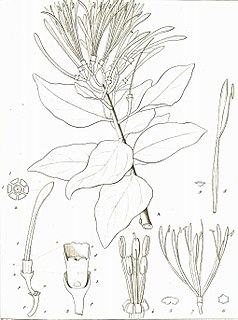
Psittacanthus calyculatus,, is a species of neotropical mistletoe in the family Loranthaceae, native to Colombia, Mexico, the Mexican Gulf and Venezuela.
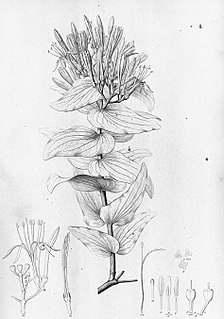
Psittacanthus cordatus is a species of neotropical mistletoe in the family Loranthaceae, which is native to Bolivia and Brazil.
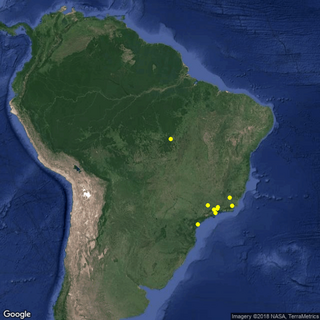
Psittacanthus brasiliensis is a species of neotropical mistletoe in the family Loranthaceae, which is endemic to Brazil.
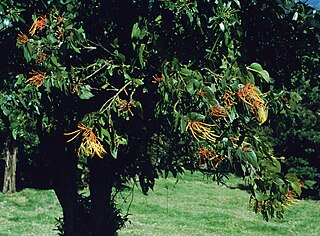
Psittacanthus schiedeanus G.Don is a species of neotropical mistletoe in the family Loranthaceae, which is native to Panamá, Costa Rica, Honduras and Mexico.
Job Kuijt, is a Canadian botanist, with particular interest in Viscaceae, Loranthaceae and Eremolepidaceae

Psittacanthus acinarius is a species of mistletoe in the family Loranthaceae, which is native to Bolivia, Brazil, Colombia, Costa Rica, Ecuador, Peru, Venezuela, and French Guiana.

Muellerina bidwillii, common name Cypress-pine mistletoe, is a hemiparasitic arial shrub in the family Loranthaceae. The species is endemic to New South Wales and Queensland.
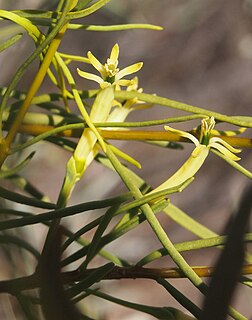
Lysiana murrayi is an erect or spreading hemi-parasitic shrub in the Loranthaceae which occurs in all mainland states of Australia except Victoria. It has flat narrow leaves. The leaves are 2.5-6 cm long, 1–3.5 mm wide, do not have a distinct petiole, and the venation is not visible. The inflorescence is a solitary flower or pair of flowers without a common peduncle. The pedicels are 8–20 mm long, and strongly winged towards the apex. The spreading, membranous bracts are 2–3 mm long, and rounded at the apex. The corolla of the mature bud is usually 18–28 mm long, and white, yellow or pink. The fruit is globose, 7–12 mm long, and pink or red.

Muellerina myrtifolia, common name myrtle-leaved mistletoe, is a hemiparasitic arial shrub in the family Loranthaceae. The species is endemic to New South Wales and Queensland.

Muellerina celastroides, common names Banksia mistletoe and coast mistletoe, is a hemiparasitic arial shrub in the family Loranthaceae. The species is endemic to New South Wales, Victoria and Queensland.

Cecarria is a monotypic genus in the family Loranthaceae. The sole species is Cecarria obtusifolia, a hemiparasitic aerial shrub.
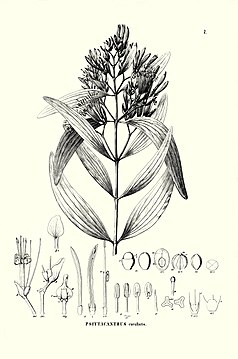
Psittacanthus cucullaris is a species of mistletoe in the family Loranthaceae, and is native to Costa Rica, Bolivia, Colombia, Ecuador, French Guiana, Peru, Suriname, Venezuela and Brazil.






















